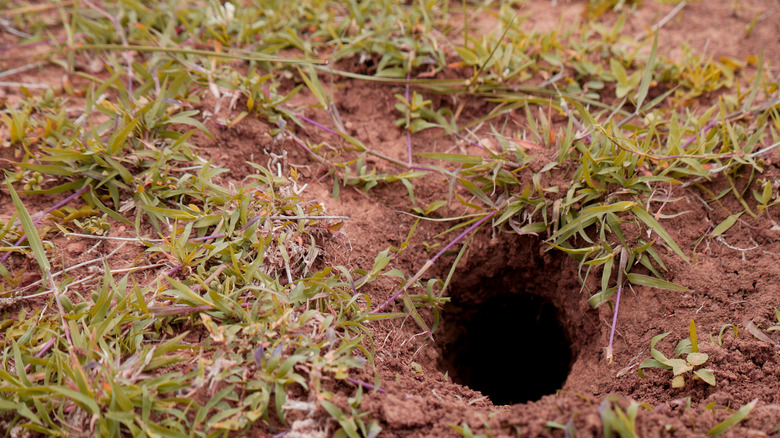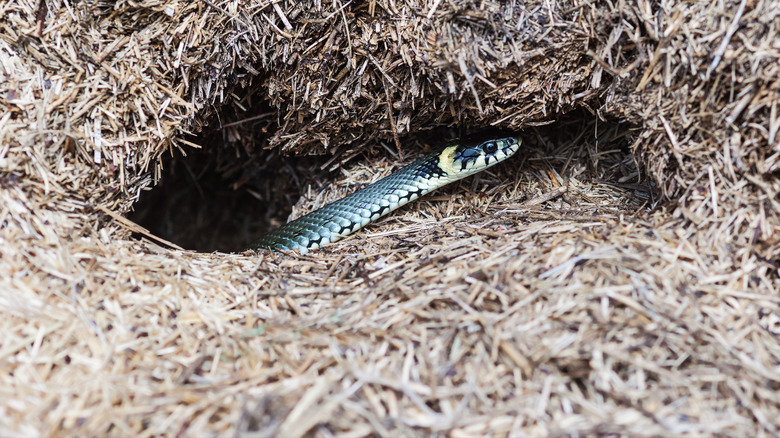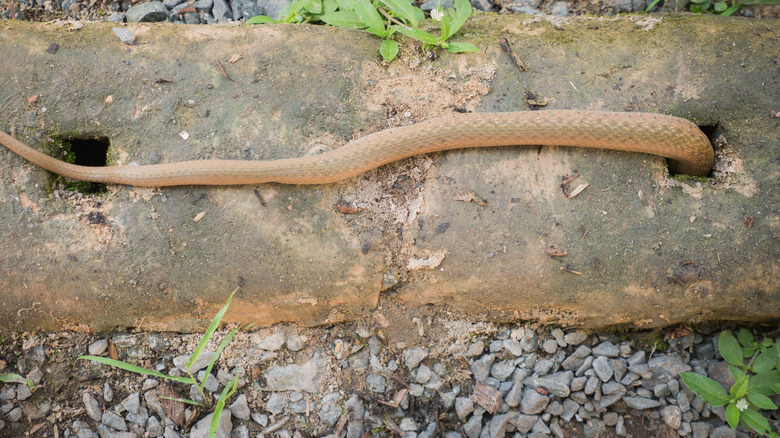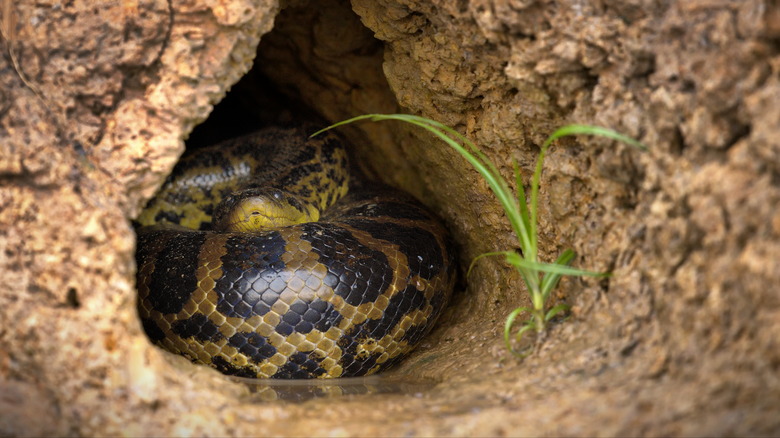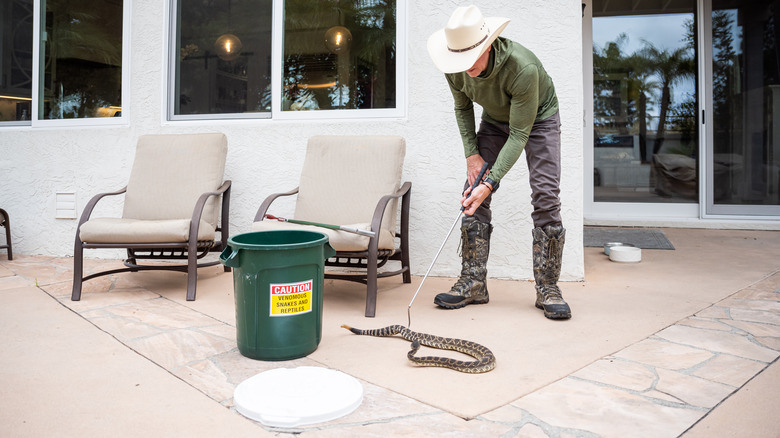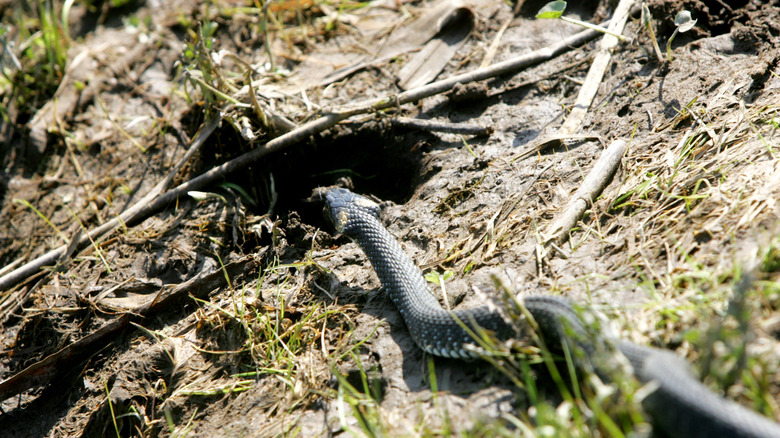What You Need To Do About Snake Holes In Your Yard
The term "snake holes" can be misleading, as snakes do not dig their own burrows. They are opportunistic creatures that utilize holes created by other animals like rodents, foxes, and badgers. These burrows are found in soft, sandy soil, under piles of leaves or logs, or within grassy areas. The snakes use these ready-made shelters for protection, hunting, and brumation (a hibernation-like state during cold seasons).
According to Dr. Charles B. van Rees, a conservation scientist and nature guide who runs a blog dedicated to understanding the outdoors, Gulo in Nature, awareness of this behavior helps in identifying potential snake habitats and managing them effectively. He told Outdoor Guide that snakes may go into holes for just a few hours or move in for days, but if you suspect a snake is hiding out in a hole in your yard the first thing to know is "if the original architect has moved out and you've got a snake tenant, you'll want to know what species of snake you're dealing with."
If a snake has taken over, try to determine what type it is and its danger level, then act accordingly by either leaving the snake alone or by contacting your local wildlife control agency. Awareness of the natural behavior of snakes can reduce unnecessary fear and promote coexistence. Moreover, knowing that these holes are a result of a diverse ecosystem can help homeowners appreciate the complexity of their backyard habitats.
Identifying snake holes and signs of snake activity
Identifying a snake hole involves looking for specific signs and characteristics. Dr. van Rees says, "It's hard to tell if a snake has moved into a hole, but a good sign might be snake droppings or shed skin nearby." The holes are usually circular or oval and can vary significantly in size, from small ones the size of a quarter to larger openings several inches across. These burrows are often found under logs, piles of leaves, or in tall grassy areas. Van Rees added, "If the tailings of the hole or the soil around it are relatively powdery or sandy, you might see tracks of a snake slithering through, another good indicator."
Snake feces, on the other hand, are typically dark brown smears with a white end, which is uric acid, a common metabolic byproduct in reptiles. Finding these signs around a hole can confirm snake activity and help in deciding the next steps.
Assessing and dealing with snake holes safely
Before approaching a suspected snake hole, taking safety precautions is essential. Wearing protective gloves can prevent snake bites. Observing the hole during early mornings or late afternoons, when snakes are likely to bask in the sun near their shelters, can help identify active burrows. For a less invasive approach, setting up a camera can monitor the hole over time, providing insights into the snake's habits and presence. Identifying the snake species is crucial, as many common yard snakes are harmless.
Garter snakes, for example, are non-venomous and beneficial in controlling pest populations. However, if there is any indication of a venomous species, such as a rattlesnake or copperhead, professional assistance is advisable. Learning to identify local snake species can enhance safety and reduce fear during encounters. Resources like field guides or mobile apps can aid in proper identification. This knowledge empowers homeowners to handle snake situations confidently and appropriately.
Mitigating snake presence in your yard
Non-venomous snakes, such as garter snakes and rat snakes, play a beneficial role in controlling pests like rodents and insects. However, if snakes become a nuisance, several methods can help deter them. Snake repellents are available in various forms, often utilizing scents like cinnamon, clove, or ammonia, which snakes find unpleasant. Citrus fruits have also been proven to be an effective snake deterrent. Additionally, planting snake-repellent plants like marigolds and lemongrass can create a less inviting environment.
Setting humane traps is another effective method, allowing for the safe relocation of snakes. When filling or covering snake holes, ensure the material used is level with the ground to prevent reoccupation. Eliminating snake-friendly habitats is also crucial. Remove piles of leaves, rocks, and wood that provide shelter. Keep grass trimmed and reduce clutter in the yard. These measures not only deter snakes but also reduce the habitats of their prey, making the yard less attractive overall.
Legal and safe removal practices
Before taking action against snakes, it is important to check local regulations. Some regions have laws protecting certain snake species, and methods like fumigation may be restricted. For humane removal, using safe repellents or traps is recommended. These traps can capture snakes without harming them, allowing for relocation far from residential areas. Protective gloves should always be worn when handling traps to avoid bites.
Dr. van Rees recommends using apps like iNaturalist and Seek for snake identification, and goes on to say, "Above all, do not approach any snake if you do not know what species it is; try to get a photograph from some distance away."
If unsure about handling snakes, professional wildlife removal services are advisable. These experts can safely remove snakes and provide advice on preventing future infestations. Professionals can also offer education on local snake species and help identify potential risks. This approach ensures the safety of homeowners and their pets while respecting wildlife. Consulting with experts ensures compliance with local laws and effective long-term solutions.
Preventing future snake infestations
To maintain a snake-free yard, habitat modification is essential. Snakes thrive in yard environments with tall grass, under sheds, in brush and woodpiles, dense shrubbery, and abundant prey like rodents and insects. Removing these elements can deter snakes from taking up residence. Regularly mow the lawn, clear away piles of leaves, rocks, and wood, and remove any potential hiding spots. Addressing rodent infestations is equally important, as they attract snakes. Use traps or other methods to reduce rodent populations. Sealing gaps and cracks in structures, such as sheds and garages, can prevent snakes from entering these areas. Additionally, keeping firewood stacks elevated and burning firewood before spring can reduce shelter options for snakes. By making these changes, homeowners can create an environment that is less hospitable to snakes and their prey. These preventative measures are key to reducing the likelihood of future snake infestations, ensuring a safer and more enjoyable yard for all.
By following these expanded steps, homeowners can effectively manage snake holes in their yards and take proactive measures to prevent future occurrences. Understanding snake behavior, identifying signs of their presence, and using safe removal practices contribute to a harmonious coexistence with local wildlife.
